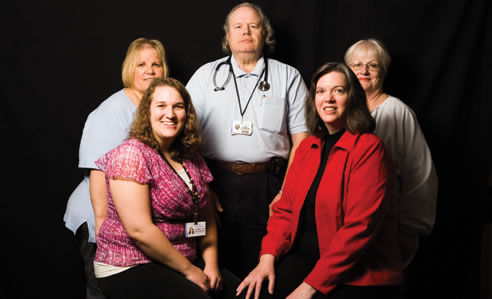Featured Initiative:

Care Management Plus:
Description of the Model: Care Management Plus
 The Intermountain Healthcare (Salt Lake City) Care Management Plus
Team: Cherie Brunker, MD (front right), and her Primary Care Team
(clockwise): Liz Garcia-Leavitt, LCSW (Care Manager), Vikie Durrant
(Receptionist), Kip DeWeese, APRN, GNP (Nurse Practitioner), Mary
Carpenter, LPN (Licensed Practical Nurse). The Team applies the
Information Technology tools and works together with their patients
and caregivers to provide efficient, high quality health care.
In the Care Management Plus model, physicians in a primary care
practice identify patients with complex care needs and refer them to a
care manager. These patients with long-term chronic diseases require
more education or more time to understand their medications or other
aspects of their care. For example, they may need to learn about
controlling their diabetes, they may be frail, or they may be at high
risk for complications.
The Intermountain Healthcare (Salt Lake City) Care Management Plus
Team: Cherie Brunker, MD (front right), and her Primary Care Team
(clockwise): Liz Garcia-Leavitt, LCSW (Care Manager), Vikie Durrant
(Receptionist), Kip DeWeese, APRN, GNP (Nurse Practitioner), Mary
Carpenter, LPN (Licensed Practical Nurse). The Team applies the
Information Technology tools and works together with their patients
and caregivers to provide efficient, high quality health care.
In the Care Management Plus model, physicians in a primary care
practice identify patients with complex care needs and refer them to a
care manager. These patients with long-term chronic diseases require
more education or more time to understand their medications or other
aspects of their care. For example, they may need to learn about
controlling their diabetes, they may be frail, or they may be at high
risk for complications.
The care manager-in consultation with the patient, family, physicians, and other health care providers-assesses the patient's needs, creates a care plan, and acts as a catalyst to make sure the care plan occurs. Care managers help patients and caregivers to self-manage their disease and navigate the health care system. They provide links to community resources and ensure that patients receive the highest quality care. The care manager also can identify possible coexisting conditions, such as depression, or other barriers that may be preventing the patient from effectively managing their illness.
“My job is to do all the things that a care manger does-screen, assess, plan, coordinate, and monitor,” says Ann Larsen, RN, CDE, Care Manager, Intermountain Healthcare Medical Group, Roy, Utah. “But I also treat the whole patient. For example, a patient might be referred to me for diabetes, but the patient is depressed. We can't work on the diabetes until the depression is addressed. My job is to find out what's causing the patient to have a difficult time managing his or her illness. Most patients want to be well. They just may not know how.”
 Care Management Plus provides a variety of printed and virtual tools
to assist both doctors and older patients in managing complex health
conditions.
An electronic information system facilitates the work of the
interdisciplinary team by incorporating protocols and reminders for
optimal care of patients. For example, the Care Management Tracking
database keeps track of tasks, such as following up with other
clinicians, calling patients to check in with them, and assuring tests
are ordered. It also keeps track of patient outcomes. A Patient
Summary sheet contains pertinent health information. Electronic
messaging systems help providers gain access to care plans, remind
them about the best health care practices for the patient's condition,
and facilitate communication among the health care team. The system
also creates reports for ongoing assessment and administration of a
care management program.
Care Management Plus provides a variety of printed and virtual tools
to assist both doctors and older patients in managing complex health
conditions.
An electronic information system facilitates the work of the
interdisciplinary team by incorporating protocols and reminders for
optimal care of patients. For example, the Care Management Tracking
database keeps track of tasks, such as following up with other
clinicians, calling patients to check in with them, and assuring tests
are ordered. It also keeps track of patient outcomes. A Patient
Summary sheet contains pertinent health information. Electronic
messaging systems help providers gain access to care plans, remind
them about the best health care practices for the patient's condition,
and facilitate communication among the health care team. The system
also creates reports for ongoing assessment and administration of a
care management program.
“Having these tools helps the clinic to be more efficient,” says Cherie Brunker, MD, co-principal investigator, Care Management Plus. “Before I see a patient, the system has identified lab work, such as liver function tests or other routine tests for a specific patient, and the office staff puts that in the queue to be ordered. It's done automatically.”
These freely available information technology tools were developed by
Drs. Clayton and Wilcox at Intermountain Healthcare as part of the
project supported by the Foundation. Care managers can use these tools
to access disease-specific recommendations and reminders. This
technology is specifically created for and by care managers and care
teams that are responsible for the care of older adults.
Next Page › “Care managers augment what the doctor does. Physicians
feel better
about the medicine that they practice and patients feel better about
the care they have received. Overall, the outcome is better health.” Linda Leckman, MD
Chief Executive Officer,
Intermountain Medical Group
Next: Illustration: Care Management Plus Model ›
